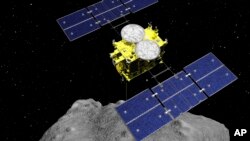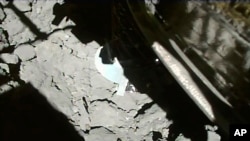Japan’s space agency says a Japanese spacecraft successfully landed on an asteroid Thursday and collected material from under its surface.
The Hyabusa2 spacecraft landed briefly inside a small crater on the asteroid Ryugu. The space agency reported that it rose safely from the surface after collecting dust and rock samples.
Space scientists hope that tests of the material will provide information about the formation of our solar system.
Officials with the Japanese Aerospace Exploration Agency, known as JAXA, excitedly announced the results. They said data confirmed that the spacecraft had landed on Ryugu and returned to a position above the surface.
After the operation was completed, everyone in the command center stood up and cheered.
“It was a success, a big success,” said Takashi Kubota, a project member. He added that the operation had been successful in all its planned activities.
A complex project
In April, Hyabusa2 fired a two kilogram object into the surface, creating a crater on the asteroid. On Thursday, the spacecraft returned to the same area, where it landed for only a few seconds. The goal was was to collect rock and dust samples from beneath the surface. The spacecraft shot a small object into the soil and used a tube to gather the material.
Getting to rocks and other material below the surface is important, scientists say, because it is unaffected by radiation from space and other influences.
JAXA said the samples have been safely placed in a container which will be moved to a capsule for safe storage.
The operation is the most important experiment yet by Hyabusa2. Its next project is to return safely to Earth with the soil samples.
Project manager Yuichi Tsuda said that an experiment like this has never been attempted before. “Nobody has collected and brought home underground materials from anywhere further than the moon,” he added.
Remains of solar system formation
Asteroids are the rocky objects left over from when Earth and the rest of the solar system were forming.
The asteroid Ryugu is named after the undersea home of a dragon in a traditional Japanese story. It is only about 900 meters across. The asteroid has a rocky surface that scientists believe holds carbon-based substances.
Seiichiro Watanabe is a scientist with Japan’s space agency. He noted that Hyabusa2 had now taken samples from two different areas on the asteroid. He said early pictures of the recent sample show that the material is of different colors and sizes.
Watanabe said being able to compare material from the surface and from underground was very important.
“I’m so excited about finding out about all these unknowns,” he said.
The Hyabusa2 is the first spacecraft to collect samples from under the surface of an asteroid. The United States space agency NASA plans a similar mission to an asteroid called Bennu.
Hyabusa2 will continue to take pictures of Ryugu until it begins its 300 million kilometer trip back to Earth. It is expected to return home in late 2020.
I’m Mario Ritter Jr.
Mari Yamaguchi reported this story for The Associated Press. Mario Ritter Jr. adapted the report for VOA Learning English, with additional material from VOA. George Grow was the editor.
We want to hear from you. Write to us in the Comments section, and visit our Facebook page.
_______________________________________________________________
Words in This Story
asteroid –n. space rocks that orbit the sun mostly between the orbits of Mars and Jupiter
crater –n. a round hole caused by an explosion or impact
capsule –n. part of a spacecraft that is separate from the rest of the ship
dragon –n. an imaginary animal that can breath fire and fly









